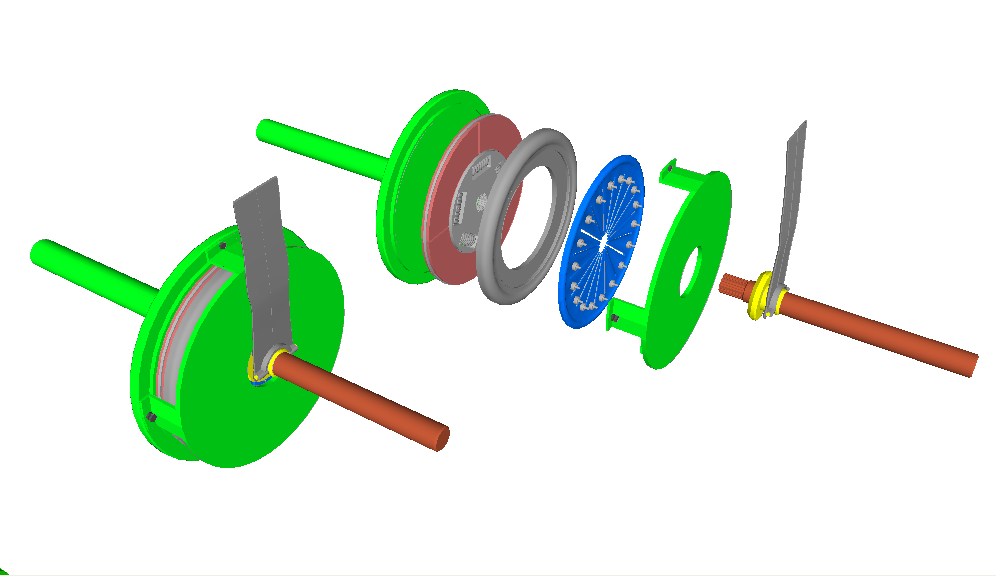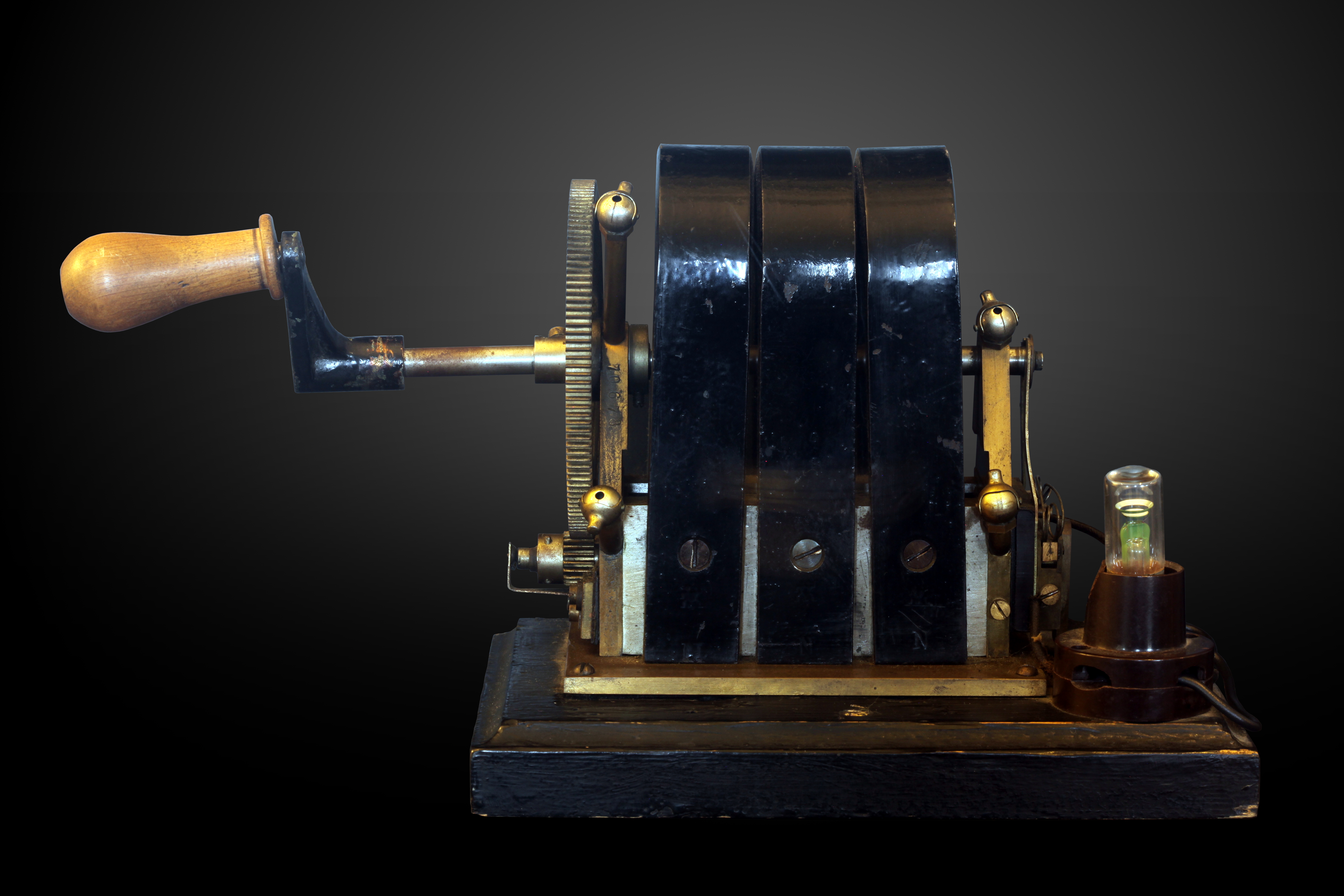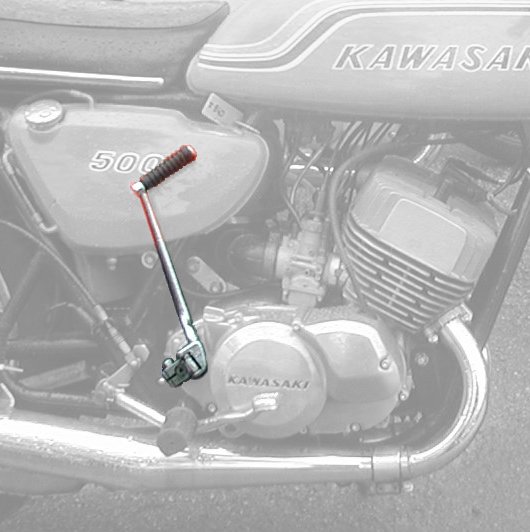|
Yamaha Libero (G5)
Yamaha Libero G5 is a 106 cc, single-cylinder four-stroke motorcycle manufactured by India Yamaha Motor. Its predecessor was known as just Yamaha Libero. Unlike Libero G5, Libero had tachometer and round headlights but lacked fuel gauge. However, Libero G5 came with a sporty headlight and fuel gauge, but lacked the tachometer. A new set of air scoops with a honeycomb grille do dual duty; directing airflow over the engine block and also neatly covering the gap between the engine and the fuel tank. The Libero G5's frame continues to be the tubular dual-cradle type. Yamaha has introduced a compulsive pressure wet sump lubrication system in the 106 cc engine of the Libero G5. This new system works on a constant pressure build-up that is generated by the engine itself thus enables the engine oil or lubricant to flow evenly over all the engine components, unlike conventional lubrication that works more on gravitational forces thus may not perform as effectively. Yamaha Libero G ... [...More Info...] [...Related Items...] OR: [Wikipedia] [Google] [Baidu] |
India Yamaha Motor
is a Japanese multinational manufacturer of motorcycles, marine products such as boats and outboard motors, and other motorized products. The company was established in 1955 upon separation from Yamaha Corporation (however, Yamaha Corporation is still the largest private company shareholder with 9.92%, as of 2019), and is headquartered in Iwata, Shizuoka, Japan. The company conducts development, production and marketing operations through 109 consolidated subsidiaries as of 2012. Led by Genichi Kawakami, the company's founder and first president, Yamaha Motor spun off from musical instrument manufacturer Yamaha Corporation in 1955 and began production of its first product, the YA-1 125cc motorcycle. It was quickly successful and won the 3rd Mount Fuji Ascent Race in its class. The company's products include motorcycles, scooters, motorized bicycles, boats, sail boats, personal water craft, swimming pools, utility boats, fishing boats, outboard motors, 4-wheel ATVs, recreat ... [...More Info...] [...Related Items...] OR: [Wikipedia] [Google] [Baidu] |
Hero Honda Splendor
The Hero Splendor+ is an entry level motorcycle manufactured in India by Hero motocorp. It has an electronic ignition and a tubular double cradle type frame with a engine. The engine is based on the Honda Cub C100EX with a similar bore and stroke of . , Splendor models were selling at a rate of one million units per year. History Splendor was launched as a successor to the Hero Honda CD100 and the Hero Honda Sleek, both inspired by the Honda CB250RS series of the 1980s. In 2004, Hero Honda launched the upgraded version of the Splendor, the Splendor+. This version features multi-reflector headlight, tail light and turn signal lights, and new graphics. In 2007, Hero Honda launched the Splendor plus with changes in body fairings and including alloy wheels and other improvements. In 2011, Hero Honda launched the Splendor Pro with changes in body fairings, self-start features, alloy wheels and other improvements. In 2011 when Hero Honda was rebranded as Hero Motocorp,Hero badge ... [...More Info...] [...Related Items...] OR: [Wikipedia] [Google] [Baidu] |
Gear Ratio
A gear train is a mechanical system formed by mounting gears on a frame so the teeth of the gears engage. Gear teeth are designed to ensure the pitch circles of engaging gears roll on each other without slipping, providing a smooth transmission of rotation from one gear to the next. Features of gears and gear trains include: * The gear ratio of the pitch circles of mating gears defines the speed ratio and the mechanical advantage of the gear set. * A planetary gear train provides high gear reduction in a compact package. * It is possible to design gear teeth for gears that are non-circular, yet still transmit torque smoothly. * The speed ratios of chain and belt drives are computed in the same way as gear ratios. See bicycle gearing. The transmission of rotation between contacting toothed wheels can be traced back to the Antikythera mechanism of Greece and the south-pointing chariot of China. Illustrations by the Renaissance scientist Georgius Agricola show gear trains with ... [...More Info...] [...Related Items...] OR: [Wikipedia] [Google] [Baidu] |
Clutch
A clutch is a mechanical device that engages and disengages power transmission, especially from a drive shaft to a driven shaft. In the simplest application, clutches connect and disconnect two rotating shafts (drive shafts or line shafts). In these devices, one shaft is typically attached to an engine or other power unit (the driving member), while the other shaft (the driven member) provides output power for work. Typically the motions involved are rotary, but linear clutches also exist. In a motor vehicle, the clutch acts as a mechanical linkage between the engine and transmission, and briefly disconnects, or separates the engine from the transmission system. This disconnects the drive wheels whenever the clutch pedal is depressed, allowing the driver to smoothly change gears. In a torque-controlled drill, for instance, one shaft is driven by a motor, and the other drives a drill chuck. The clutch connects the two shafts so they may be locked together and spin at the ... [...More Info...] [...Related Items...] OR: [Wikipedia] [Google] [Baidu] |
Battery (electricity)
An electric battery is a source of electric power consisting of one or more electrochemical cells with external connections for powering electrical devices. When a battery is supplying power, its positive terminal is the cathode and its negative terminal is the anode. The terminal marked negative is the source of electrons that will flow through an external electric circuit to the positive terminal. When a battery is connected to an external electric load, a redox reaction converts high-energy reactants to lower-energy products, and the free-energy difference is delivered to the external circuit as electrical energy. Historically the term "battery" specifically referred to a device composed of multiple cells; however, the usage has evolved to include devices composed of a single cell. Primary (single-use or "disposable") batteries are used once and discarded, as the electrode materials are irreversibly changed during discharge; a common example is the alkaline battery used ... [...More Info...] [...Related Items...] OR: [Wikipedia] [Google] [Baidu] |
Magneto (electrical)
A magneto is an electrical generator that uses permanent magnets to produce periodic pulses of alternating current. Unlike a dynamo, a magneto does not contain a commutator to produce direct current. It is categorized as a form of alternator, although it is usually considered distinct from most other alternators, which use field coils rather than permanent magnets. Hand-cranked magneto generators were used to provide ringing current in telephone systems. Magnetos were also adapted to produce pulses of high voltage in the ignition systems of some gasoline-powered internal combustion engines to provide power to the spark plugs. Use of such ignition magnetos for ignition is now limited mainly to engines without a low-voltage electrical system, such as lawnmowers and chainsaws, and to aircraft engines, in which keeping the ignition independent of the rest of the electrical system ensures that the engine continues running in the event of alternator or battery failure. For redundancy ... [...More Info...] [...Related Items...] OR: [Wikipedia] [Google] [Baidu] |
Capacitor Discharge Ignition
Capacitor discharge ignition (CDI) or thyristor ignition is a type of automotive electronic ignition system which is widely used in outboard motors, motorcycles, lawn mowers, chainsaws, small engines, turbine-powered aircraft, and some cars. It was originally developed to overcome the long charging times associated with high inductance coils used in inductive discharge ignition (IDI) systems, making the ignition system more suitable for high engine speeds (for small engines, racing engines and rotary engines). The capacitive-discharge ignition uses capacitor discharge current to the coil to fire the spark plugs. History Nikola Tesla The history of the capacitor discharge ignition system can be traced back to the 1890s when it is believed that Nikola Tesla was the first to propose such an ignition system. In first filed February 17, 1897, Tesla writes 'Any suitable moving portion of the apparatus is caused to mechanically control the charging of a condenser and its discharge ... [...More Info...] [...Related Items...] OR: [Wikipedia] [Google] [Baidu] |
Ignition System
An ignition system generates a spark or heats an electrode to a high temperature to ignite a fuel-air mixture in spark ignition internal combustion engines, oil-fired and gas-fired boilers, rocket engines, etc. The widest application for spark ignition internal combustion engines is in petrol (gasoline) road vehicles such as cars and motorcycles. Compression ignition Diesel engines ignite the fuel-air mixture by the heat of compression and do not need a spark. They usually have glowplugs that preheat the combustion chamber to allow starting in cold weather. Other engines may use a flame, or a heated tube, for ignition. While this was common for very early engines it is now rare. The first electric spark ignition was probably Alessandro Volta's toy electric pistol from the 1780s. Siegfried Marcus patented his "Electrical igniting device for gas engines" on 7 October 1884. History Magneto systems The simplest form of spark ignition is that using a magneto. The engine spins ... [...More Info...] [...Related Items...] OR: [Wikipedia] [Google] [Baidu] |
Carburettor
A carburetor (also spelled carburettor) is a device used by an internal combustion engine to control and mix air and fuel entering the engine. The primary method of adding fuel to the intake air is through the venturi tube in the main metering circuit, however various other components are also used to provide extra fuel or air in specific circumstances. Since the 1990s, carburetors have been largely replaced by fuel injection for cars and trucks, however carburetors are still used by some small engines (e.g. lawnmowers, generators and concrete mixers) and motorcycles. Diesel engines have always used fuel injection instead of carburetors. Etymology The name "carburetor" is derived from the verb ''carburet'', which means "to combine with carbon," or in particular, "to enrich a gas by combining it with carbon or hydrocarbons." Thus a carburetor mixes intake air with hydrocarbon-based fuel, such as petrol or autogas (LPG). The name is spelled "carburetor" in American English a ... [...More Info...] [...Related Items...] OR: [Wikipedia] [Google] [Baidu] |
Kick Start
Kick start is a method of starting an internal combustion engine (usually that of a motorcycle) by pushing a ratcheting lever with one's foot. Kick start mechanisms were almost universally a part of motorcycle engines before the mid-1970s, and were phased out of production over the next twenty years or so as electric starters became standard equipment. There are still some motorcycles produced that have both kick and electric starters. Many mopeds and scooters also carry both a kick start and an electric start, the former being useful in case the latter fails, as scooter and moped batteries tend to be smaller and, as a result, run down much faster than other forms of automotive batteries. Also, it is usually not possible to push start a moped or scooter with automatic transmission. Larger motorcycles featured a manual compression release mechanism that made starting easier while modern units did this automatically through a cable attached to the kick start lever. Today, dedic ... [...More Info...] [...Related Items...] OR: [Wikipedia] [Google] [Baidu] |
Compression Ratio
The compression ratio is the ratio between the volume of the cylinder and combustion chamber in an internal combustion engine at their maximum and minimum values. A fundamental specification for such engines, it is measured two ways: the static compression ratio, calculated based on the relative volumes of the combustion chamber and the cylinder when the piston is at the bottom of its stroke, and the volume of the combustion chamber when the piston is at the top of its stroke. The dynamic compression ratio is a more advanced calculation which also takes into account gasses entering and exiting the cylinder during the compression phase. Effect and typical ratios A high compression ratio is desirable because it allows an engine to extract more mechanical energy from a given mass of air–fuel mixture due to its higher thermal efficiency. This occurs because internal combustion engines are heat engines, and higher compression ratios permit the same combustion temperature to ... [...More Info...] [...Related Items...] OR: [Wikipedia] [Google] [Baidu] |
Single-cylinder
A single-cylinder engine, sometimes called a thumper, is a piston engine with one cylinder. This engine is often used for motorcycles, motor scooters, go-karts, all-terrain vehicles, radio-controlled vehicles, portable tools and garden machinery (such as lawnmowers, cultivators, and string trimmers). Single-cylinder engines are made both as 4-strokes and 2-strokes. Characteristics Compared with multi-cylinder engines, single-cylinder engines are usually simpler and compact. Due to the greater potential for airflow around all sides of the cylinder, air cooling is often more effective for single cylinder engines than multi-cylinder engines. This reduces the weight and complexity of air-cooled single-cylinder engines, compared with liquid-cooled engines. Drawbacks of single-cylinder engines include a more pulsating power delivery through each cycle and higher levels of vibration. The uneven power delivery means that often a single-cylinder engine requires a heavier flywheel than a ... [...More Info...] [...Related Items...] OR: [Wikipedia] [Google] [Baidu] |







